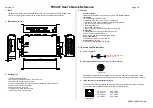
Connect to green
wire w/red stripe
F
S
A
I
CONNECT THE BATTERY.
SYSTEM CHECK
♦
Apply a moderate load to the charging system (i.e., high beam headlights and A/C for example) and
bring the engine to 1,500rpm. Using a digital voltmeter measure the DC voltage from a metal point
on the case of the alternator to the negative battery terminal. Readings higher than 0.10VDC indi-
cate a poor ground connection. Check the ground path including any paint or anodizing on the
brackets, the engine ground strap, and the ground cable from the frame to the battery. (See figure 2).
♦
With battery fully charged and engine running at 1,500rpm, measure
the voltage at battery positive post (+) and the ground post (-). Voltage
should be 13.8~14.5VDC. Readings above 15.5VDC indicate a defec-
tive alternator and readings below 12.7VDC indicate that the alternator
is not functioning or cannot supply the present amperage needs of the
vehicle at this engine speed.
♦
Using the voltmeter, measure the voltage drop between the batty positive post (+) and the alternator
output post (See figure 3). Voltage should be less that 0.40VDC. If voltage is higher that 0.40VDC,
check for poor connections between the alternator and the battery. Possible causes are under sized
battery cables, loose or improperly crimped terminals, and corroded connections.
FIGURE 2
FIGURE 3
1966~1985
WITH
EXTERNAL
REGULATOR
AND FACTORY
VOLTMETER
1986~1993
WITH
INTERNAL
REGULATOR
AND
FACTORY
VOLTMETER
#1 pin
Batt. post
#1 pin
Batt. post
A Word About “Indicator Lights”...
Some Fords came OE with an indicator light on the dash to signal the alternator’s state during
operation. Under normal operation the light should come on any time the ignition switch is on and the
engine is stopped. When the alternator is not functioning and the engine is running, the light will
come on to warn the driver of this condition. OE alternators require that this circuit function for
proper alternator function whereas Powermaster alternators do not require this. The light will simply
be off at all times.
Optionally this indicator light function can be used on a Powermaster alternator in vehicles with a
factory voltmeter by removing the black rubber cover on the side of the alternator and connecting the
indicator light circuit to the #1 terminal of the Powermaster alternator.
Vehicles with a factory
ammeter cannot use this function.
Need to change a pulley?
To remove the alternator pulley, use
an air impact wrench to loosen the
nut with one hand, while holding the alternator
pulley with the other. It is recommended that
protective gloves and eyewear be used. If an air
impact wrench is not available, a 5/16” hex bit
socket and ratchet can be used to hold the alterna-
tor shaft, while a typical 15/16” boxed-end wrench
can be used to loosen the nut. The pulley nut uses
standard, right-hand threads. So to remove, rotate
in a counterclockwise direction.
Install the replacement pulley, lock washer,
and nut by hand.
Torque the pulley nut to 70 ft. lbs. and be
certain the lock washer is completely
closed. Do not over tighten.
Why is my voltage low when I’m cruising around at a show or sitting at a traffic light?
All alternators have an output curve that increases with RPM. In other words, your alternator cannot provide as many amps at idle as it can at higher speeds. If you car
demands more amperage than the alternator can supply at idle, the remaining amps must come from the battery thus a decrease in voltage results. Any after market
pulleys that slow the alternator relative to the engine [i.e. power pulleys] can greatly magnify this problem.
Why does my voltage test good at the alternator but low at the battery and fuse box?
Any resistance in the electrical path will decrease voltage. This includes all positive
and negative
conductors and connections between the alternator and the second test
point. All connections must be secure and free of corrosion. All ground points must be free of paint and rust. Charging wires must be of adequate size for the amperage
capabilities of your alternator. Improving any weak points in the electrical paths should bring voltage readings to within 0.5 volts of each other.
So what is the difference between a one wire and a “three wire” hookup?
The difference is the way the alternator is switched on. With one wire operation the alternator internally senses its rotation and switches its self on. With “three wire”
operation an external exciter wire switches on the alternator. Three wire operation is as your vehicle’s original manufacture intended and assures that the alternator is
switched on anytime the engine is running. “Three wire” is an industry term that describes a situation that in most cases can be accomplished using only two wires [the
exciter wire and the charge wire].




















